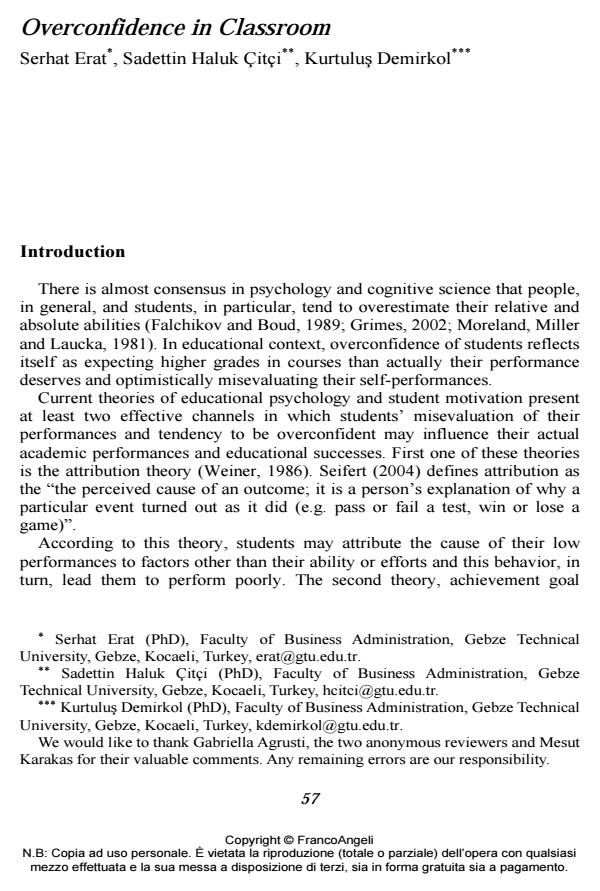Overconfidence in Classroom
Titolo Rivista CADMO
Autori/Curatori Serhat Erat, Citci Sadettin Haluk, Kurtulus Demirkol
Anno di pubblicazione 2016 Fascicolo 2016/1 Lingua Inglese
Numero pagine 13 P. 57-69 Dimensione file 159 KB
DOI 10.3280/CAD2016-001007
Il DOI è il codice a barre della proprietà intellettuale: per saperne di più
clicca qui
Qui sotto puoi vedere in anteprima la prima pagina di questo articolo.
Se questo articolo ti interessa, lo puoi acquistare (e scaricare in formato pdf) seguendo le facili indicazioni per acquistare il download credit. Acquista Download Credits per scaricare questo Articolo in formato PDF

FrancoAngeli è membro della Publishers International Linking Association, Inc (PILA)associazione indipendente e non profit per facilitare (attraverso i servizi tecnologici implementati da CrossRef.org) l’accesso degli studiosi ai contenuti digitali nelle pubblicazioni professionali e scientifiche
Current theories of educational psychology and academic motivation assert that confidence of students in their own abilities and performances is an important determinant of their academic performances. In an experimental setting, we examine whether students accurately estimate or overestimate their performances. We establish that most of students exhibit overconfidence in their abilities and performances. More importantly, we find that overconfidence of students significantly decreases their academic performances. The negative relation between overconfidence and academic performance depends on the field of study and is stronger for students studying at Department of Electronic Engineering and Department of Material Science and Engineering. Moreover, our results indicate no significant gender differences in overconfident behavior. Findings of the paper suggest that in order to form effective teaching and grading strategies, teachers and pedagogues should consider effects of student’s tendency to be overconfident.
Keywords:Overconfidence, judgment accuracy, field of study, student performance, student motivation
- http://dokuman.osym.gov.tr/pdfdokuman/2015/YGS/2015-YGSSAYISALBILGILER19032015.pdf.
- Atherton, M. (2015), “Measuring Confidence Levels of Male and Female Students in Open Access Enabling Courses”, Issues in Educational Research, 25 (2), pp. 81-98.
- Barber, B.M., Odean, T. (2001), “Boys Will be Boys: Gender, Overconfidence, and Common Stock Investment”, The Quarterly Journal of Economics, 116, 1, pp. 261-292.
- Beckmann, D, Menkhoff, L. (2008), “Will Women be Women? Analyzing the Gender Difference among Financial Experts”, article first published online 17 July 2008, http://onlinelibrary.wiley.com/doi/10.1111/j.1467-6435.2008.00406.x/epdf.
- Bengtsson, C., Persson, M., Willenhag, P. (2005), “Gender and Overconfidence”, Economics Letters, 86, 2, pp. 199-203.
- Biais, B., Hilton, D., Mazurier, K., Pouget, S. (2008), “Judgemental Overconfidence, Self-Monitoring and Trading Performance in an Experimental Financial Market”, Review of Economic Studies, 72 (2), pp. 287-312.
- Citci, S.H., Eren, I. (2016), “Career Concerns and Bayesian Overconfidence of Managers”, International Journal of Industrial Economics, 46, pp. 137-159.
- Crawford, J.D., Stankov, L. (1996), “Age Differences in the Realism of Confidence Judgements: A Calibration Study using Tests of Fluid and Crystallized Intelligence”, Learning and Individual Differences, 8, pp. 83-103.
- Dunlosky, J., Rawson, K.A. (2012), “Overconfidence produces Underachievement: Inaccurate Self-evaluations Undermine Students’ Learning and Retention”, Learning and Instruction, 22 (4), pp. 271-280. Dysinger, W.S., Wilkins, P.E. (1954) “Students Estimate Their Own Grades”, School and Society, 80, pp. 198-199.
- Falchikov, N., Boud, D. (1989), “Student Self-assessment in Higher Education: A Meta-analysis”, Review of Educational Research, 59 (4), pp. 395-430.
- Grimes, P.W. (2002), “The Overconfident Principles of Economics Student: An Examination of a Metacognitive Skill”, Journal of Economic Education, 33 (1), pp. 15-30.
- Hossain, B., Tsigaris, P. (2015), “Are Grade Expectations Rational? A Classroom Experiment”, Education Economics, 23, 2, pp. 199-212.
- http://dokuman.osym.gov.tr/pdfdokuman/2015/LYS/2015LYSSAYISALBILGILER30062015.pdf.
- Job, R.S. (1990), “The Application of Learning Theory to Driving Confidence. The Effect of Age and the Impact of Random Breath Testing”, Accident Analysis & Prevention, 22, pp. 97-107.
- Kruger, J., Dunning, D. (1999), “Unskilled and Unaware of it: How Difficulties in Recognizing One’s Own Incompetence lead to inflated Self-assessments”, J. Pers. Soc. Psychol., 77 (6), Dec., pp. 1121-1134.
- Malmendier, U., Tate, G. and Yan, J. (2011), “Overconfidence and Early-Life Experiences: The Effect of Managerial Traits on Corporate Financial Policies”. The Journal of Finance, 66, pp. 1687-1733.
- Menkhoff, L., Schmeling, M., and Schmidt, U. (2013), “Overconfidence, Experience, and Professionalism: An Experimental Study”, Journal of Economic Behavior & Organization, 86, pp. 92-101.
- Mooi, T.L. (2006), “Self-efficacy and Student Performance in an Accounting Course”, Journal of Financial Reporting and Accounting, 4, 1, pp. 129-146.
- Moreland, R., Miller, J., Laucka, F. (1981), “Academic Achievement and Selfevaluation of Academic Performance”, Journal of Educational Psychology, 73, 3, pp. 335-344.
- Murstein, B.I. (1965), “The Relationship of Grade Expectations and Grades Believed to Be Deserved to Actual Grades Received”, The Journal of Experimental Education, 33 (4), pp. 357-362.
- Nicholls, J.G., Cobb, P., Wood, T., Yackel, E., Patashnick, M. (1990), “Assessing Students’ Theories of Success in Mathematics: Individual and Classroom Differences”, Journal for Research in Mathematics Education, 21, 2, pp. 109-122.
- Nowell, C., Alston, R.M. (2007), “Thought I got an A! Overconfidence across the Economics Curriculum”, Research in Economic Education, 38, pp. 131-142.
- Paola, M.D., Gioia, F., Scoppa, V. (2014), “Overconfidence, Omens and Gender Heterogeneity: Results from a Field Experiment”, Journal of Economic Psychology, 45, pp. 237-252.
- Pintrich, R., Garcia, T. (1991), “Student Goal Orientation and Self Regulation in the College Classroom”, in M. Maehr, P. Pintrich (eds), Advances in Motivation and Achievement. Greenwich (CT): Jai Press, pp. 371-402. Pliske, R.M. Mutter, S.A. (1996), “Age Differences in the Accuracy of Confidence Judgments”, Experimental Aging Research, 22, pp. 199-216.
- Seifert, T.L. (2004), “Understanding Student Motivation”, Educational Research, 46 (2), pp. 137-49.
- The Global Gender Gap Report (2014), The World Economic Forum.
- Weiner, B. (1986), An Attributional Theory of Motivation and Emotion. New York: Springer-Verlag.
- Yates, J.F., Lee, J.W., Shinotsuka, H. (1996), “Beliefs about Overconfidence, including Its Cross-national Variation”, Organizational Behavior and Human Decision Processes, 65, pp. 138-147.
Serhat Erat, Citci Sadettin Haluk, Kurtulus Demirkol, Overconfidence in Classroom in "CADMO" 1/2016, pp 57-69, DOI: 10.3280/CAD2016-001007